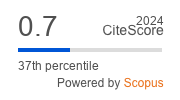Role of MRI diffusion weighted imaging in differentiation between benign and malignant ovarian masses
DOI:
https://doi.org/10.47723/kcmj.v13i2.33Keywords:
diffusion weighted imaging, MRI, benign and malignant ovarian masses.Abstract
Background: Characterization of the ovarian masses preoperatively is important to inform the surgeon about the possible management strategies. MRI may be of great help in identifying malignant lesion before surgery. Diffusion Weighted Imaging (DWI) is a sensitive method for changes in proton of water mobility caused by pathological alteration of tissue cellularity, cellular membrane integrity, extracellular space perfusion, and fluid viscosity.
Objective: to study the diagnostic accuracy of DWI in differentiation between benign and malignant ovarian masses.
Type of the study:Cross-sectional study.
Methods: this study included 53with complex ovarian mass or masses ,Diffusion Weighted Imaging was obtained to all these patient with correlation to the histopathological results; the Signal Intensity (SI) of the solid and cystic part of the lesions was evaluated on T2 and Diffusion Weighted Imaging ,with Apparent Diffusion Coefficient (ADC) values were also obtained .
Results: 22 masses out of the total 53 were malignant and 31 were benign .On DWI the high SI intensity observed more frequently in the malignant lesions than the benign lesions (p value 0.0293) .There was significant difference between the mean ADC value of the malignant and benign ovarian lesions, with the mean ADC value for the benign lesions solid component =1.05 x10 -3, and the mean ADC value for the malignant lesions solid component =0.91 x10-3. The ROC study reveals that 0.926 x 10 -3 may be the optimal cutoff value with sensitivity 54.8 %, specificity 59.1%, NPV 48.15 %, PPV 63.39% , Accuracy 56.6%. With exclusion of the teratoma and endometriomas from statistical analysis the ROC reveals that 0.99 x10 -3 may be the optimal cut off value with sensitivity 76.9 % , specificity 77.3% , PPV 66.67% , NPP 85% and accuracy 77.14% Conclusions: Combined with conventional pelvic MRI, DWI is a helpful tool in differentiation between benign and malignant ovarian masses, with high signal intensity on DWI more frequently observed in the malignant than benign ovarian lesions.













